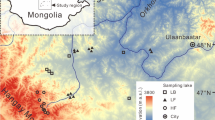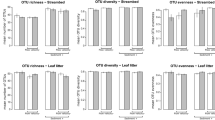Abstract
The distribution, evolutionary relationships, and acid-resistance level (including mechanisms behind it) were studied in acid-tolerant chironomid species in Japan. All six species studied showed a tendency of restricted distribution. Chironomus acerbiphilus showed the highest acid tolerance with 50% survival at pH 0.75, whilst C. cf. riparius and C. solicitus showed the 2nd highest tolerance. Tolerance mechanisms, including enzymatic protein digestion into smaller molecules, was strongly observed, even at pH 2.0 in C. sulfurosus. Additionally, C. cf. riparius displayed the highest H+-ATPase activity; however, the same activity level was observed in both acid-tolerant and non-tolerant species. Phylogenetic analysis did not result in any exclusive acid-tolerant clades, although C. cf. riparius and C. solicitus formed an exclusive small clade within the genetic tree based on their cytochrome oxidase I (CO I) region. Other acid-tolerant species were grouped within clades with non-tolerant species. C. cf. riparius and C. solicitus, distributed only in northern Japan, were estimated to have diverged from ancestral species earlier, while C. fusciceps and C. sulfurosus, distributed only in southern Japan, diverged later. These results point to the possibility of Japanese acid-tolerant chironomids originating in northern area and later expanding their range to southern areas.



Similar content being viewed by others
References
Doi H, Kikuchi E (2002) Analysis of food resources of acid-resistant chironomid larvae in strongly acidic lake, Katanuma. Rikusuigaku Zasshi 63:160–162 (in Japanese)
Edwards FW (1929) British non-biting midges (Diptera, Chironomidae). Trans Entomol Soc Lond 77:279–439
Frouz J, Lobinske RJ, Yaqub A, Ali A (2007) Larval gut pH profile in pestiferous Chironomus crassicaudatus and Glyptotendipes paripes (Chironomidae: Diptera) in reference to the toxicity potential of Bacillus thuringiensis serovar israelensis. J Am Mosq Control Assoc 23:355–358
Havas M, Hutchinson TC (1982) Aquatic invertebrates from the Smoking Hills, NWT: effects of pH and metals on mortality. Can J Fish Aquat Sci 39:890–903
Jernelov A, Nagell B, Svenson A (1981) Adaptation to acid environment in Chironomus riparius (Diptera, Chironomidae) from Smoking Hills, NWT, Canada. Holarct Ecol 4:116–119
Kawai K, Konishi K (1986) Fundamental studies on chironomid allergy II. Analyses of larval allergens of some Japanese chironomids (Chironomidae, Diptera). Jpn J Allergol 35:1088–1098
Kawai K, Hashimoto M, Imabayashi H (2004) Environmental factors affecting the quality and quantity of hemoglobin in Chironomus larvae (Diptera: Chironomidae). Med Entomol Zool 55:281–287
Mizota C, Maki Y (1998) Sulfur isotopic variations in soft tissues of Calyptogena soyoae from Sagami Bay, central Japan. Geochem J 32:421–425
Nihon yusurika kenkyu-kai (2010) Illustrated guide to the Chironomidae of Japan. Bun-ichisogoshuppan, Tokyo, p 353
Ohsugi T (2006) Phylogenic studies on the Japanese chironomid genus Polypedilum. Master thesis, Graduate School of Biosphere Science, Hiroshima University (in Japanese)
Pinder LCV (1986) Biology of freshwater Chironomidae. Ann Rev Entomol 31:1–23
Pinder LCV (1995) The habitats of chironomid larvae. In: Armitage PD, Cranston PS, Pinder LCV (eds) The Chironomidae: Biology and ecology of non-biting midges. Chapman and Hall, England, pp 106–135
Sanchez B, de los Reyes-Gavilan CG, Margolles A (2006) The F1F0ATP-ase of Bifidobacterium animalis is involved in bile tolerance. Environ Microbiol 8:1825–1833
Sasa M, Kikuchi M (1995) Chironomidae of Japan. University of Tokyo Press, Tokyo, p 333
Sasa M, Yasuno M, Ito M, Kikuchi T (1980) Studies on chironomid midges of the Tama River. Part 1. The distribution of chironomid species in a tributary in relation to the degree of pollution with sewage water. Res Rep Nat Inst Environ Stud 13:1–8
Simon C, Franti F, Beckenbach A, Crespi B, Liu H, Flook P (1994) Evolution, weighting and phylogenetic utility of mitochondrial gene sequences and a compilation of conserved polymerase chain reaction primers. Ann Entomol Soc Am 87:651–701
Tamura T (1979) An introduction to fish physiology. Kouseisha kouseikaku, Tokyo, p 276 (in Japanese)
Thompson JD, Higgins DG, Gibson TJ (1994) CLUSTAL W: improving the sensitivity of progressive multiple sequence alignment through sequence weighting, positions-specific gap penalties and weight matrix choice. Nucleic Acids Res 22:4673–4680
Tokunaga M (1938) Chironomidae from Japan. X. New or little known midges, with description of the metamorphoses of several species. Philipp J Sci 65:318–383
Tokunaga M (1939) Chironomidae from Japan (Diptera). XI. New or little known midges, with special reference to the metamorphoses of torrential species. Philipp J Sci 69:297–339
Tokunaga M (1940) Chironomidae from Japan. XII. New or little known Ceratopogonidae and Chironomidae. Philipp J Sci 72:255–317
Wiederholm T (1989) Chironomidae from the holarctic region—keys and dignoses. Entomol Scand Suppl 34:532
Yamamoto M (1990) Study of the Japanese Chironomus inhabiting highly acidic water. II. Kouchu 58:167–181
Author information
Authors and Affiliations
Corresponding author
Additional information
Handling Editor: Wataru Makino.
Rights and permissions
About this article
Cite this article
Kawai, K., Kawaguchi, K., Kodama, A. et al. Fundamental studies on acid-tolerant chironomids in Japan. Limnology 20, 101–107 (2019). https://doi.org/10.1007/s10201-018-0552-4
Received:
Accepted:
Published:
Issue Date:
DOI: https://doi.org/10.1007/s10201-018-0552-4




